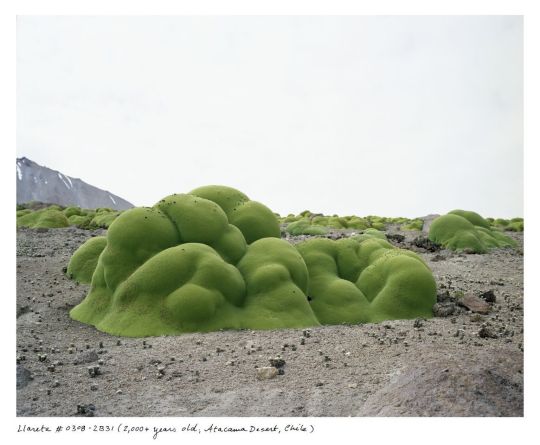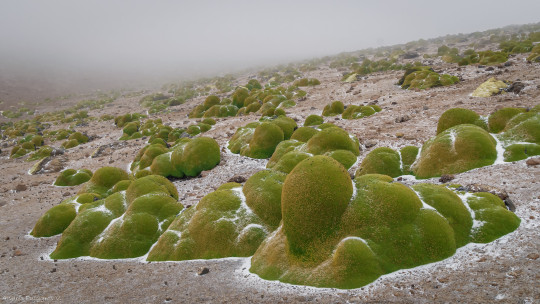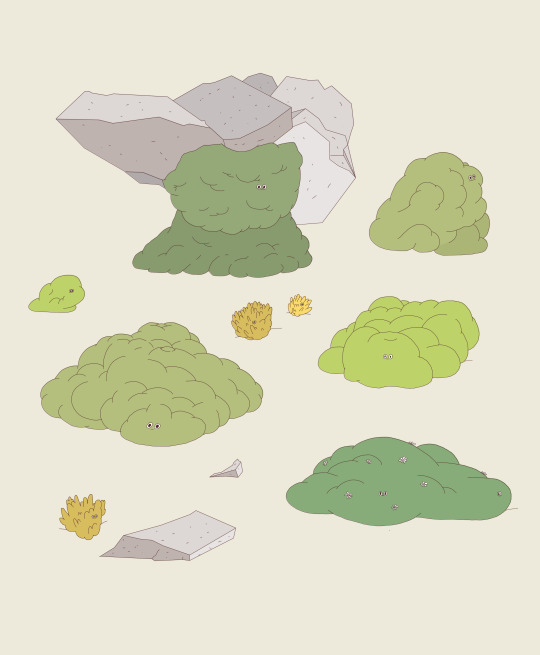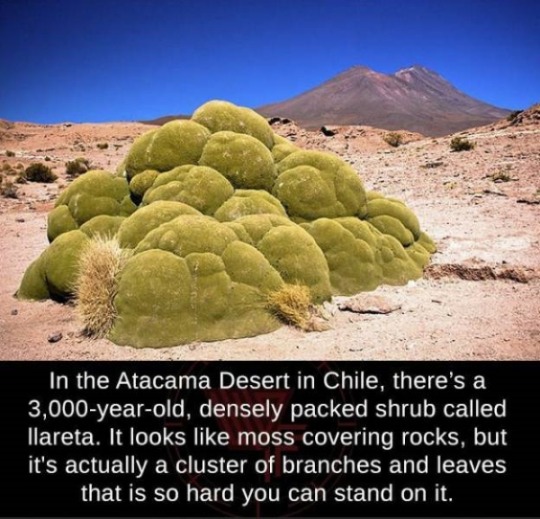#llareta
Text

llareta / Azorella compacta, one of the oldest plants in the world — some are over 2000-3000 years old. Photograph by Rachel Sussman.
20 notes
·
View notes
Text

from: https://www.instagram.com/p/CG995jfAmNK/
17 notes
·
View notes
Photo



Yareta or llareta is a velvety, chartreuse cushion plant in the family Apiaceae which is native to South America. It grows in the Puna grasslands of the Andes in Peru, Bolivia, northern Chile and western Argentina at altitudes between 3,200 and 5,250 metres.
Photos by Andres Puiggros V.
#plants#green goo#nature#landscape#yareta#south america#frost#green#naturecore#curators on tumblr#andes#mountains#fog#mist#uploads#grasslands
3K notes
·
View notes
Text
I want u all to share in this knowledge with me that if the Last City is anywhere near the atacama desert or its neighboring mountains then theres probably these little guys (azorella compacta, or llareta). and thats beautiful.


#destiny 2#i am an Azorella compacta stan for life#yes i have too much interest in south america flora
148 notes
·
View notes
Text

A 3000 year old shrub called a llareta covered in thousands of flowering blooms.
20 notes
·
View notes
Text
sobre si realmente se enredan las venas
bajo un río de sombras
el cráneo de un suicida se cubre de llaretas.
pequeñas algas verdes le implantan
una lengua de coral con la que
besar almejas y húmedas corvinas.
si tuviera algo más,
una sensación interna,
hablaría
y diría que este mar de lágrimas al que
viaja con el arrastre sombrío de los sedimentos
no es un cementerio
si no la mecedora de todo lo vivo.
estoy seguro
porque eso que no dice,
con su lengua que baila bajo
los silencios subfluviales más opacos,
bien podría escribirse
o componerse para que suenen
en algún lado ecos
sin origen sonoro aparente.
para que mil historias se pierdan en el ruido
mientras chispean los cables como clickeando
glitcheados su propia invisibilidad.
pero la lengua verde del cráneo perdido
destila sus hongos en otro orden
ajeno al lenguaje o a toda forma siquiera
de comunicación.
así almejas y corvinas tengan su propia
impresión de lo amado y sientan
en su corazón acuático
que hay algo ahí que por más vacío
que se vea les devuelve
siempre el gesto,
está muerto y no sólo
vegetales se alimentan de su rastro,
de su emoción descompuesta,
sino también quizá
cuantas formas de vida rocen
en algún bit del tiempo
las luces que verdes y casi frágiles
rebotan de sus papilas postizas.
a mí me paso algo,
parece decir el suicida degollado,
no voy a decir qué,
que me torció el habla y así quedé:
fantasma inquieto bajo un río oscuro,
lleno de una vida que no es la mía...
la mía no está y no sé en qué bingo ya
la habré apostado y perdido.
entonces el tobogán vegetal de sus palabras
se desarticula quizá en busca
de otro recipiente y el sonido otra vez
se ahoga en el agua mansa de los fondos.
mudas las piedras,
como criadas a legumbres y ácidos grasos,
sufren el espectáculo febril de la nueva
muerte diaria del hueso esférico,
sin ofrecer ya su abrazo
aunque naden, irredentas y hasta frías,
alrededor cientos de corrientes eléctricas.
no se sabe, es imposible
saberlo, si en la superficie
algún mosquito guarda al menos
una porción
de lo que fuera la sangre circulante
al interior del viejo cráneo
que sin mayor testigo ni cariño
poco a poco completa su desaparición total.
5 notes
·
View notes
Text

Yareta (Azorella compacta)
2K notes
·
View notes
Photo

Staying Alive in the Atacama
The Llareta (or yareta) plant (Azorella Compacta) of the Atacama Desert is well known for being one of the longest living organisms on the planet. Some of the larger specimens have been calculated to be approximately 3000 years old. While this is, by itself, a magnificent feat, the llareta holds some of it's most wonderful characteristics close. Literally.
Botanically speaking, these plants are masters at taking advantage of their desert environments, flaunting adaptations on par with the cactus'. As it's scientific name might suggest, llareta is composed of stems, often very long in older plants, that support a rosette of leaves that are tightly packed together. This type of compact growth is a valuable adaptation in a desert climate as it reduces the surface area to volume ratio – a smart move when you are trying to reduce evaporation.
When smaller stems are blocked from the sun, they die back, creating packing material that makes the interior of llareta very dense. It's so dense, in fact, that they can bear the full weight of a person seemingly without harm. But the dense core of these cushions provide a very helpful service for the plant. Not only is it a perfect sponge for holding water during times of drought, it is also a great way to keep the interior of the plant cool during the hottest parts of the day.
The plant's habitat preferences also help to reduce water loss. New plants often take advantage of small cracks in the rock surfaces in the desert (as shown in the picture below). These cracks provide perfect microclimates that offer cooler temperatures in hot weather, warmer temperatures in cold weather, more water during drought, and shelter from the winds that can blast through the open spaces. It also appears that the fringes of established plants create new microclimates also suitable for new, baby llareta.
Llareta has also found a niche in another aspect of life in the Atacama; humans have been using the plant for centuries, up to the present. The dense core is perfect for fires and even creates a flammable resin that produces a slow, nearly smokeless fire. Because of these valuable traits, it was used in mining operations and to power trains. However, the desirability of the plant has also caused its decline, and llareta is now an endangered species. This is particularly troubling because llareta also has some promising medicinal properties. Several studies, dating as far back as 1982 have shown that it is effective in treating diabetes caused by obesity.
Further Reading: Wickens, G. E. “Llareta (Azorella Compacta, Umbelliferae): A review”. Economic Botany. April-June 1995, Volume 49, Issue 2, pp 207-212 Photo Courtesy of Magnus von Koeller
Colter
#llareta#yareta#Azorella Compacta#atacama#plant#desert#succulent#water#the earth story#microclimate#niche#botany#biology
2K notes
·
View notes
Photo

Somewhere in Bolivia
That green bubbly looking guy is Yareta or Llareta (Azorella compacta) — a flowering plant native to the high altitude regions (10,000' - 15,000') of the Andes in Peru, Bolivia, northern Chile, and western Argentina. They often live as long as 3,000 years, making some specimens, among the oldest living organisms on the planet.
Instagram
Prints
#landscape#photographers on tumblr#Bolivia#South America#desert#nature#outdoors#travel#wanderlust#Yareta#Llareta#Apiaceae#Azorella compacta#lensblr#orignal photgraphers#Brian Stowell#brianstowell
1K notes
·
View notes
Text

from: http://flickrhivemind.net/Tags/llareta/Interesting
1 note
·
View note
Photo

the things you find in the valley...
#beautifulblob #greengoo #delinquentvalley
#nature#plantworld#llareta#beautifulblob#greengoo#beauty#desertlife#iwannafeelit#greenery#mothernature#plantlife#dope#apiaceae family#delinquentvalley
6 notes
·
View notes
Text

In the Atacama Desert in Chile, there's 3,000-year-old, densely packed shrub called llareta. It looks like moss covering rocks, but it's actually a cluster of branches and leaves that is so hard you can stand on it.
14 notes
·
View notes
Photo

Que es lindo el rugby y su gente 🏉, que nunca se pierda la mística ✨ me llenan completito el corazón 💚 Gracias 🙌🏼 @llaretasfemarica @arica_rugby . . . #rugby #rugbygirls #instarugby #rugby7s #rugbywoman #rugbyarica #aricarugby #norte #chilerugby #rugbychile #rugbylife #rugbygram #rugbyplayer #aricachile #aricasiemprearica #xvregion #llaretas #llaretasrc #llaretasrugbyclub #llaretasfem #nopainnogain #estemundoesperfecto (en Estadio Carlos Dittborn) https://www.instagram.com/p/B1K7lBYpcaN/?igshid=1uc1qe6xkfwz3
#rugby#rugbygirls#instarugby#rugby7s#rugbywoman#rugbyarica#aricarugby#norte#chilerugby#rugbychile#rugbylife#rugbygram#rugbyplayer#aricachile#aricasiemprearica#xvregion#llaretas#llaretasrc#llaretasrugbyclub#llaretasfem#nopainnogain#estemundoesperfecto
0 notes





